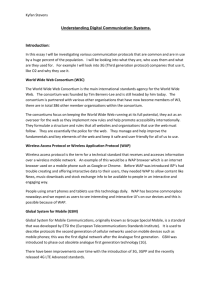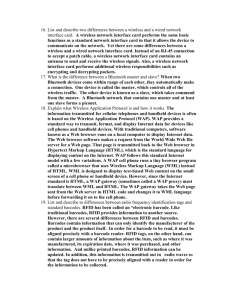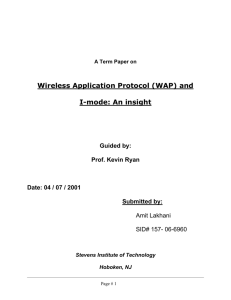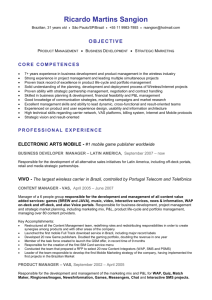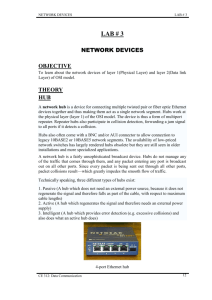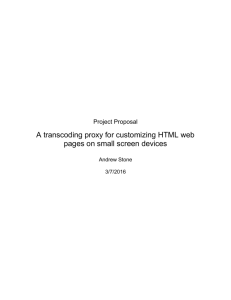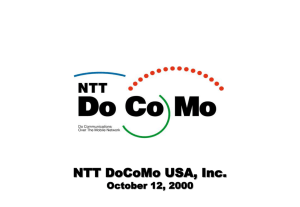Draft - Online Directory Western Illinois University
advertisement
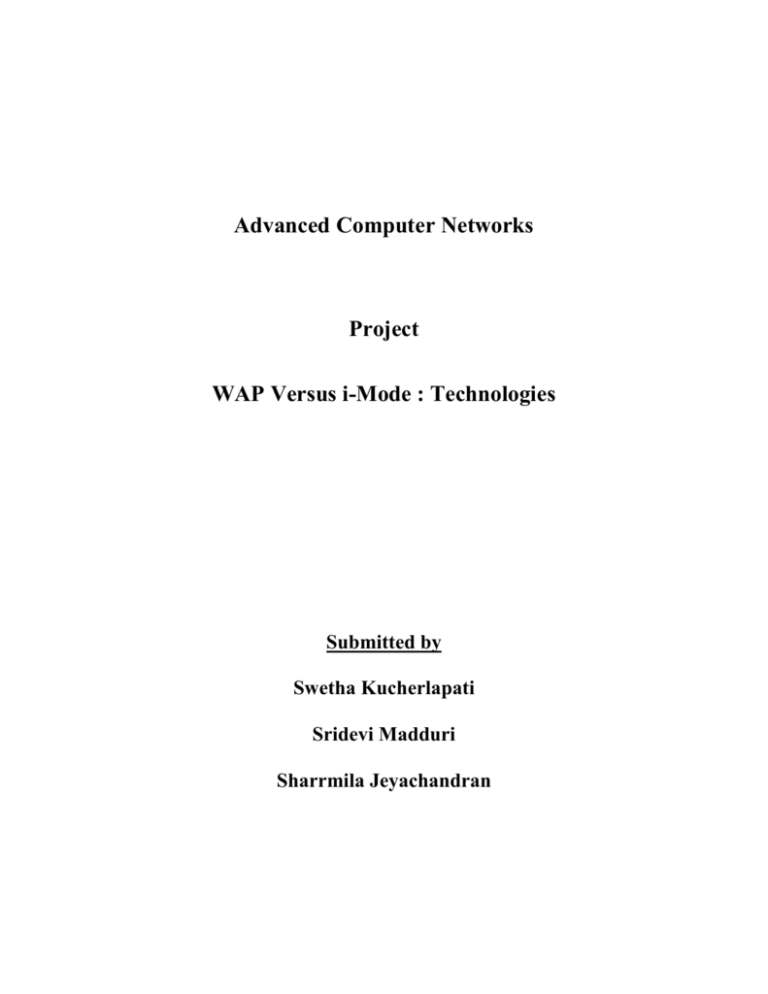
Advanced Computer Networks Project WAP Versus i-Mode : Technologies Submitted by Swetha Kucherlapati Sridevi Madduri Sharrmila Jeyachandran Introduction The Internet has become the largest and the most widely accessible information warehouse in the world. The wireless network has become a mass-market due to the large number of potential users it targets. The latest trends in wireless technology are freeing us from the constraints that wires and desktop computing have placed on our access to information and services. Now we can execute transactions and communicate anytime and anywhere, through cell-phones and PDA's. Mobile devices such as cell phones, pagers or PDAs are fast becoming the terminals of millions of users all over the world. In this project, we focus on two flavors of wireless service, as provided by the WAP Forum and by NTT DoCoMo of Japan. WAP is the Wireless Application Protocol, an open, global specification that empowers mobile users with wireless devices to easily access and interact with information and services instantly. i-Mode is a proprietary mobile ISP and portal service from NTT DoCoMo, Japan. Wireless Application Protocol is a specification for presenting and interacting with information on wireless and other devices. It provides mobile data services that allow mobile phones to browse. i-Mode is a complete mobile Internet service. Today, WAP and i-Mode are both minimized versions of the World Wide Web, but in different ways. WAP is a protocol used by hundreds, if not thousands, of companies, while i-Mode is an entire infrastructure operated by one company. Currently most WAP implementations are on top of circuit-switched networks while i-Mode is developed on top of DoCoMo’s packetswitched network. Both i-Mode and WAP are complex systems, and it is really only possible to compare present implementations of i-Mode and WAP, as well as their business models, pricing, marketing and so forth. Wireless Application Protocol WAP is the gateway to a new world of mobile data. It provides a universal standard which enables users to easily access Web based interactive information services and applications from the screens of their mobile phones. The purpose of WAP is to provide operators, infrastructure, terminal manufacturers and content developers a common environment that should enable development of value-added services for mobile phones. WAP is developed by WAP forum that has over 500 members which includes Motorola, Nokia, and Ericsson etc. It also works on most wireless devices such as Cellular telephones, Handhelds, Laptops, Pagers and Personal Digital Assistants (PDAs). i-Mode I-Mode service uses packet communication network that is built onto DoCoMo's main network. This packet data transmission technology allows for constant connectivity. Thus, users are not charged for how long they are online, since this time is unlimited. Rather, users are charged only for how much information they retrieve. In order to connect a cellular network to a server, a gateway must exist and also the web site must be in i-Mode format. A gateway translates wireless requests from a mobile phone to the server. It also sends information from a gateway back to the mobile phone. I-Mode can be used to exchange e-mail with computers, personal digital assistants and other I-Mode cellular phones. I-Mode has already captured majority of the market share in Japan and is being considered a success story in the world. Services provided by WAP and iMode WAP - For mobile operators, WAP promises to improve existing services, such as interfaces to voice mail and prepaid systems, and facilitating an unlimited range of new value-added services and applications, such as account management and billing inquiries. Operators can differentiate from their competitors by offering customized information without making more investment in infrastructure. There is a possibility of operators making a comprehensive one stop shop mobile portal for its subscribers in order to maximize its network usage. WAP follows the Internet model; it is easier for developers to write content using WML, which is a subset of XML (Extensible Markup Language). This provides significant revenue opportunities for them in the area of mobile banking, on-line ticketing, retailing and comparison-shopping. IMODE - offers a wide range of online and often interactive services, such as mobile banking, news and stock updates, telephone directory service, restaurant guide, ticket reservations, etc. Subscribers can also exchange e-mail with computers, personal digital assistants and other I-Mode cellular phones. Nearly 100 companies have linked their IMode Web pages with DoCoMo's portal IP Web site. In addition, more than 550 companies and individuals have independently launched I-Mode Web sites. Architecture WAP uses WML for communication between a special protocol conversion device called a WAP Gateway (GW) and content on the Internet. The WAP GW converts between WML and HTML, allowing delivery of WAP based content to a WAP capable mobile device. In most networks today, the connection between the MSC and the GW is circuit switched in which the MSC must utilize the Public Switched Telecommunications Network (PSTN) to connect to the GW. The WAP gateway translates the WAP request from a client (mobile device) to a web request before sending it to the host server hosting the web site written in WML. The response is translated into the WAP response by the WAP gateway and can be viewed on the mobile device. As mobile network operators deploy next generation packet-data technologies such as General Packet Radio Service (GPRS), the connection between the MSC and the WAP GW will be upgraded to leverage the faster packet connection facilitated by the GPRS network. In contrast to WAP, i-Mode utilizes an overlay packet network for direct communications (no gateway needed) to the content providers on the Internet. Networking Environment WAP is an industry initiated world standard that allows the presentation and delivery of information and services to wireless devices such as mobile telephones or handheld computers. The major players in the WAP space are the Wireless Service Provider (WSP) and the Enterprise. The WSP is the wireless equivalent of an Internet Service Provider (ISP). The role of the WSP is to provide access to back-end resources for wireless users. i-Mode provides Internet service using Personal Digital Cellular-Packet (PDC-P) and a subset of HTML 3.0 for content description. It allows application/content providers to distribute software to cellular phones and also allows users to download applets. Packet switching systems send and receive information by dividing messages into small blocks called packets and adding headers containing address and control information to each packet. This allows multiple communications to be carried on a common channel. The mobile packet communications system has a network configuration in which the packet communications function is added and integrated into DoCoMo’s Personal Digital Cellular (PDC) which is the digital system for portable and automobile telephones. Comparison The most basic difference is the different graphic-capabilities. i-Mode's packet switched data network is more suited for transferring data than WAP's circuit switched network.. We might also argue that extensive graphic-support is not necessary for small mobile devices, since most of what people might want to do over their wireless phone would be checking their email, some stock-quotes, weather- or traffic reports and the like. Another major difference is the ``always-on'' capabilities of i-Mode. Different Markup Languages are utilized by the two competing technologies. i-Mode, , uses cHTML, a subset of HTML, while WAP uses WML, a subset of XML. cHTML, while certainly easier to develop in from a web-designers standpoint, has its limits. On the other hand, since WML is derived from XML, it is much more extensible.

